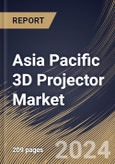Within the dynamic realm of visual technology, 3D projectors serve as paradigms of progress, fundamentally altering individuals' interactions with and perceptions of content. The market has witnessed dynamic growth fueled by technological advancements, increasing consumer demand for immersive experiences, and expanding applications across various industries. The adoption of these projectors can be traced back to their cinematic origins. The success of 3D movies in theater paved the way for a gradual transition to home entertainment systems. Today, these projectors have become integral components of home theaters, offering viewers an immersive cinematic experience within the comforts of their homes.
Additionally, the gaming community has played a pivotal role in driving the adoption of these projectors. Gamers sought more immersive and realistic experiences, and 3D projection technology provided an avenue for heightened engagement. They have found a niche among gaming and multimedia enthusiasts, from action-packed adventures to simulation games. Likewise, in the professional sphere, 3D projectors have found applications in corporate presentations and training sessions. Visualizing complex data, architectural designs, and product prototypes in three dimensions has proved instrumental in conveying information with unparalleled clarity. This adoption trend reflects a shift toward more engaging and impactful business communication.
As Indian educational institutions align with global learning standards, integrating advanced technologies becomes imperative. According to Invest India's data, the nation’s preschool sector is expected to grow by $7.35 Bn by 2028, exhibiting a growth rate of 11.2% from 2023-2028. India is making notable strides in modern K-12 education, with 230 million students and 1.46 million schools active. India is becoming Ed Tech capital of the world; out of 36 Ed-Tech unicorn companies, 7 are Indian, which are valued at $34.05 Bn in June 2022. Hence, the growing education sector in the Asia Pacific will assist in expanding the regional market.
The China market dominated the Asia Pacific 3D Projector Market by Country in 2022, and would continue to be a dominant market till 2030; thereby, achieving a market value of $644.3 million by 2030. The Japan market is registering a CAGR of 7% during (2023 - 2030). Additionally, The India market would showcase a CAGR of 8.3% during (2023 - 2030).
Based on Technology, the market is segmented into DLP, LCD, and LCOS. Based on Light Source, the market is segmented into Metal Halide, Laser, LED, and Hybrid & Others. Based on Brightness, the market is segmented into 2000 to 3999 Lumens, 4000 to 9999 Lumens, Less Than 2000 Lumens, and 10000 & Above Lumens. Based on Resolution, the market is segmented into HD & Full HD, VGA, XGA, and 4K and Above. Based on End User, the market is segmented into Cinema, Business, Education, Home Theater & Gaming, Events & Large Venues, and Others. Based on countries, the market is segmented into China, Japan, India, South Korea, Singapore, Malaysia, and Rest of Asia Pacific.
List of Key Companies Profiled
- Sony Corporation
- Seiko Epson Corporation
- Panasonic Corporation
- NEC Corporation
- Acer, Inc.
- Canon, Inc.
- Coretronic Corporation
- ViewSonic Corporation
- Dell Technologies, Inc.
- Boxlight Corporation
Market Report Segmentation
By Technology (Volume, Hundred Units, USD Billion, 2019-2030)- DLP
- LCD
- LCOS
- Metal Halide
- Laser
- LED
- Hybrid & Others
- 2000 to 3999 Lumens
- 4000 to 9999 Lumens
- Less Than 2000 Lumens
- 10000 & Above Lumens
- HD & Full HD
- VGA
- XGA
- 4K and Above
- Cinema
- Business
- Education
- Home Theater & Gaming
- Events & Large Venues
- Others
- China
- Japan
- India
- South Korea
- Singapore
- Malaysia
- Rest of Asia Pacific
Table of Contents
Companies Mentioned
- Sony Corporation
- Seiko Epson Corporation
- Panasonic Corporation
- NEC Corporation
- Acer, Inc.
- Canon, Inc.
- Coretronic Corporation
- ViewSonic Corporation
- Dell Technologies, Inc.
- Boxlight Corporation
Methodology

LOADING...








